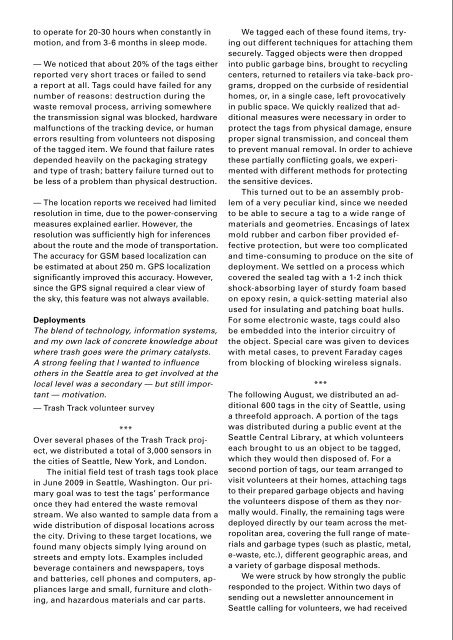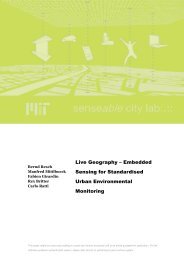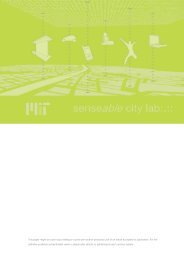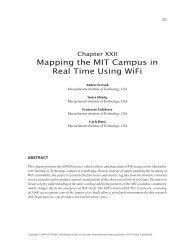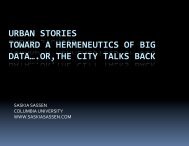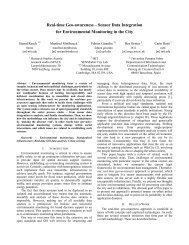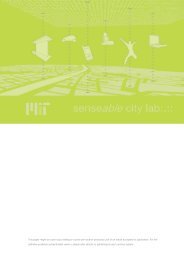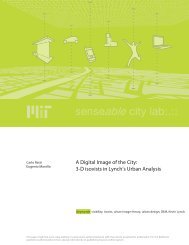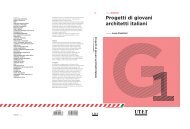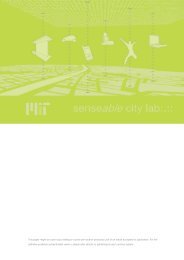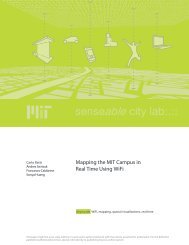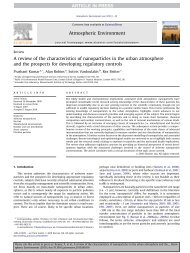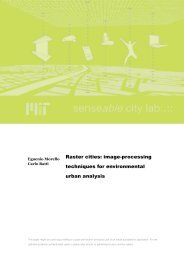Urban Digestive Systems. Towards the Sentient City. - MIT ...
Urban Digestive Systems. Towards the Sentient City. - MIT ...
Urban Digestive Systems. Towards the Sentient City. - MIT ...
- No tags were found...
You also want an ePaper? Increase the reach of your titles
YUMPU automatically turns print PDFs into web optimized ePapers that Google loves.
to operate for 20-30 hours when constantly inmotion, and from 3-6 months in sleep mode.— We noticed that about 20% of <strong>the</strong> tags ei<strong>the</strong>rreported very short traces or failed to senda report at all. Tags could have failed for anynumber of reasons: destruction during <strong>the</strong>waste removal process, arriving somewhere<strong>the</strong> transmission signal was blocked, hardwaremalfunctions of <strong>the</strong> tracking device, or humanerrors resulting from volunteers not disposingof <strong>the</strong> tagged item. We found that failure ratesdepended heavily on <strong>the</strong> packaging strategyand type of trash; battery failure turned out tobe less of a problem than physical destruction.— The location reports we received had limitedresolution in time, due to <strong>the</strong> power-conservingmeasures explained earlier. However, <strong>the</strong>resolution was sufficiently high for inferencesabout <strong>the</strong> route and <strong>the</strong> mode of transportation.The accuracy for GSM based localization canbe estimated at about 250 m. GPS localizationsignificantly improved this accuracy. However,since <strong>the</strong> GPS signal required a clear view of<strong>the</strong> sky, this feature was not always available.DeploymentsThe blend of technology, information systems,and my own lack of concrete knowledge aboutwhere trash goes were <strong>the</strong> primary catalysts.A strong feeling that I wanted to influenceo<strong>the</strong>rs in <strong>the</strong> Seattle area to get involved at <strong>the</strong>local level was a secondary — but still important— motivation.— Trash Track volunteer survey***Over several phases of <strong>the</strong> Trash Track project,we distributed a total of 3,000 sensors in<strong>the</strong> cities of Seattle, New York, and London.The initial field test of trash tags took placein June 2009 in Seattle, Washington. Our primarygoal was to test <strong>the</strong> tags’ performanceonce <strong>the</strong>y had entered <strong>the</strong> waste removalstream. We also wanted to sample data from awide distribution of disposal locations across<strong>the</strong> city. Driving to <strong>the</strong>se target locations, wefound many objects simply lying around onstreets and empty lots. Examples includedbeverage containers and newspapers, toysand batteries, cell phones and computers, applianceslarge and small, furniture and clothing,and hazardous materials and car parts.We tagged each of <strong>the</strong>se found items, tryingout different techniques for attaching <strong>the</strong>msecurely. Tagged objects were <strong>the</strong>n droppedinto public garbage bins, brought to recyclingcenters, returned to retailers via take-back programs,dropped on <strong>the</strong> curbside of residentialhomes, or, in a single case, left provocativelyin public space. We quickly realized that additionalmeasures were necessary in order toprotect <strong>the</strong> tags from physical damage, ensureproper signal transmission, and conceal <strong>the</strong>mto prevent manual removal. In order to achieve<strong>the</strong>se partially conflicting goals, we experimentedwith different methods for protecting<strong>the</strong> sensitive devices.This turned out to be an assembly problemof a very peculiar kind, since we neededto be able to secure a tag to a wide range ofmaterials and geometries. Encasings of latexmold rubber and carbon fiber provided effectiveprotection, but were too complicatedand time-consuming to produce on <strong>the</strong> site ofdeployment. We settled on a process whichcovered <strong>the</strong> sealed tag with a 1-2 inch thickshock-absorbing layer of sturdy foam basedon epoxy resin, a quick-setting material alsoused for insulating and patching boat hulls.For some electronic waste, tags could alsobe embedded into <strong>the</strong> interior circuitry of<strong>the</strong> object. Special care was given to deviceswith metal cases, to prevent Faraday cagesfrom blocking of blocking wireless signals.***The following August, we distributed an additional600 tags in <strong>the</strong> city of Seattle, usinga threefold approach. A portion of <strong>the</strong> tagswas distributed during a public event at <strong>the</strong>Seattle Central Library, at which volunteerseach brought to us an object to be tagged,which <strong>the</strong>y would <strong>the</strong>n disposed of. For asecond portion of tags, our team arranged tovisit volunteers at <strong>the</strong>ir homes, attaching tagsto <strong>the</strong>ir prepared garbage objects and having<strong>the</strong> volunteers dispose of <strong>the</strong>m as <strong>the</strong>y normallywould. Finally, <strong>the</strong> remaining tags weredeployed directly by our team across <strong>the</strong> metropolitanarea, covering <strong>the</strong> full range of materialsand garbage types (such as plastic, metal,e-waste, etc.), different geographic areas, anda variety of garbage disposal methods.We were struck by how strongly <strong>the</strong> publicresponded to <strong>the</strong> project. Within two days ofsending out a newsletter announcement inSeattle calling for volunteers, we had receivedmore than 200 responses - far beyond ourexpectations. It suggested just how engaged<strong>the</strong> general public could become in researchingwhere trash goes. This also contributed to ourdecision to set up subsequent deployments ofmany tags with expanded involvement by localvolunteers. Following our August experiment inSeattle, two smaller experiments were carriedout in <strong>the</strong> cities of New York <strong>City</strong> and London.In September of 2009, preliminary resultsfrom <strong>the</strong>se efforts were shown to <strong>the</strong> publicin exhibitions at <strong>the</strong> Seattle Public Library and<strong>the</strong> Architectural League of New York. In bo<strong>the</strong>xhibitions, a real-time visualization based oncollected sensor data provided a compellingportrait of <strong>the</strong> journey of <strong>the</strong> tracked garbage,item by item. Each representation includeda photo with <strong>the</strong> description of <strong>the</strong> disposedobject, where and when it was thrown away,and an animated view of <strong>the</strong> object’s trajectorythough <strong>the</strong> waste system. These data visualizationswere combined with a video composedby German artist Armin Linke for this exhibition,which showed scenes from <strong>the</strong> insideof waste management facilities, juxtaposingclean abstract data with <strong>the</strong> brute physicalityof waste.***In October 2009, building on experiencesfrom this initial phase and <strong>the</strong> exhibitions, weprepared for our largest deployment to date.In order to launch 2,200 location sensors in <strong>the</strong>metropolitan area of Seattle, we extended ourcollaboration with local citizens. We recruitedvolunteers through an open call in local media,in which we asked <strong>the</strong>m to provide garbageitems from <strong>the</strong>ir own households according toa wish list of items. From <strong>the</strong> pool of volunteerswho registered through our web site, weselected around 100 homes to visit, in orderto achieve an even geographic distribution ofdisposal points across <strong>the</strong> whole region.During <strong>the</strong> following three weeks, fourmobile deployment teams visited <strong>the</strong> homesof selected volunteers, elementary and highschools, and private institutions. The SeattleCentral Library served as a base of operationsfor preparing <strong>the</strong> tracking devices and <strong>the</strong>materials necessary for <strong>the</strong> deployment, aswell as for training lead volunteers who joinedus during visits to homes. On site, <strong>the</strong> team attachedtags to trash using layers of protectiveepoxy foam, and documented each item, itsmaterial properties, and <strong>the</strong> time and locationof its disposal.In order to achieve a diverse and representativeselection of household wastes, weprepared a ‘wish list’ and some guidelines forwhat we were looking for. Two main factorsshaped <strong>the</strong> selection of trash for tagging:— Primarily, <strong>the</strong> list was based on <strong>the</strong> taxonomyused by <strong>the</strong> Environmental ProtectionAgency to divide municipal solid waste intocategories based on contained materials(Office of Solid Waste 2008b). These materialcategories include organics, paper and paperboard,glass, plastics, metals, and rubber,lea<strong>the</strong>r and textiles.—The second important influence in selectingproducts was <strong>the</strong> nature of <strong>the</strong> waste collectionsystem in Seattle. In this system, differentmechanisms capture different types of waste;for example, single-stream curbside recyclingcollects aluminum cans, while food and yardwaste collection handles organic scraps, andfluorescent light bulbs are collected at householdhazardous waste centers (Seattle PublicUtilities n.d.).Extra consideration was given to emergingwaste categories such as discarded cell phones,computers, fluorescent bulbs, and o<strong>the</strong>r householdhazardous waste, which are increasinglyprevalent in <strong>the</strong> waste stream (Office of SolidWaste 2008a). These emerging waste sourceshave an array of disposal mechanisms, many ofwhich are provided by private sources, such asmanufacturer take-backs, store drop-offs, andmail-in programs. The collection rates through<strong>the</strong>se mechanisms, as well as <strong>the</strong>ir environmentalimpacts and trade-offs, are not asestablished as those of municipal solid waste.***While we varied and refined our proceduresthroughout <strong>the</strong> project, each of <strong>the</strong>se deploymentsactively involved local citizens. Besidescreating public awareness about <strong>the</strong> project,its goals, and <strong>the</strong> questions it raises, this alsoensured that we could distribute our tags in away that closely matched how people in thatcity actually disposed of <strong>the</strong>ir trash. Recruitedvolunteers came from local neighborhoods,schools, public libraries, institutions, andcompanies, collectively providing an incrediblearray of garbage items. Volunteers also98-99 <strong>MIT</strong> Senseable <strong>City</strong> Lab Trash Track


